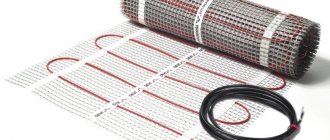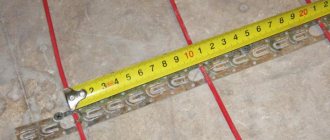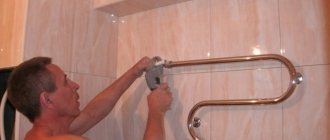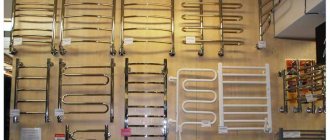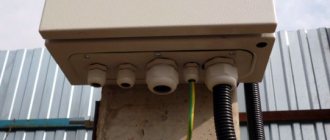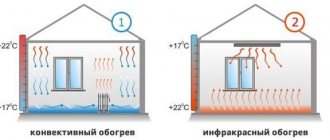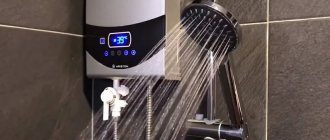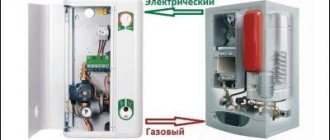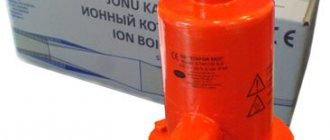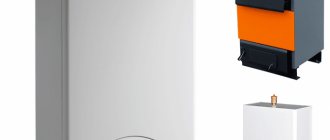Electric heated towel rail in the bathroom
How to connect an electric heated towel rail so that you don’t have to worry about the safety of the residents of your apartment and don’t bypass this device? The answer to this question is simple.
To do this, you must comply with the rules of the PUE, as well as basic safety standards during installation. And so that you don’t have any problems with this, in our article we will describe in detail not only the connection process itself, but also cover all the related issues.
Electric heated towel rails in Moscow
Electric heated towel rails and other products can be purchased at Leroy Merlin in Moscow at low prices. Select the product you are interested in on the website and buy it in our online store. The range of products presented in the catalog is extremely wide. Among them there will certainly be a position suitable in all respects.
All products presented in the “Electric heated towel rails” section are produced by well-known companies that have proven themselves to be of high quality for their products.
You can always place an order and pay for it online on the official website of Leroy Merlin in Russia. For residents of the Moscow region, we not only have low prices for products in the “Electric heated towel rails” category, but also fast delivery to cities such as Moscow, Balashikha, Podolsk, Khimki, Korolev, Mytishchi, Lyubertsy, Krasnogorsk, Elektrostal, Kolomna, Odintsovo, Domodedovo , Serpukhov, Shchelkovo, Orekhovo-Zuevo, Ramenskoye, Dolgoprudny, Pushkino, Reutov, Sergiev Posad, Voskresensk, Lobnya, Ivanteevka, Dubna, Yegoryevsk, Chekhov, Dmitrov, Vidnoye, Stupino, Pavlovsky Posad, Naro-Fominsk, Fryazino, Lytkarino, Dzerzhinsky , Solnechnogorsk, Istra and Zhukovsky.
Electric heated towel rails with hidden connection
Electrical devices are distinguished by the type of connection:
1. Electric heated towel rail with open connection;
2. Electric heated towel rail with hidden connection.
There are times when there is absolutely no desire to carry out complex repair work in a bathroom, bathroom or other room. Therefore, models with an open connection are selected, that is, using an outlet. But most often, most users think through the interior of the rooms to the smallest detail and very carefully, each stage of work is subject to close attention. In such cases, the cable wiring for power supply is precisely organized. Most often, electric heated towel rails with a hidden connection are chosen and a heated towel rail powered by electricity is a device intended for home use for additional heating of rooms or drying textiles (robes, casual clothes, towels). Typically, bathrooms are chosen to install such a device, but it is possible to install the equipment in any other convenient place. There are samples whose power will be quite enough to use the device as an additional heating source. If during the cold season, when any part of the house is not warm enough, you can use a heated towel rail to raise the air temperature to the required level. This electrical device can be used to reduce humidity levels in rooms. After powerful drying appears in the house, things will dry much faster after washing, and you can completely forget about increased dampness.
Which heated towel rail to choose?
- When first comparing water and electric heated towel rails, a significant advantage comes to the fore. The latter are convenient in the sense that they do not depend in any way on water supply systems. The location of the device will depend only on your taste, convenience or room design.
- Many users of water dryers are very upset by the seasonal shutdown of hot water and heating. In the case of a network-powered device, the user can choose the time when to turn off or turn on the heating device again.
- A significant advantage of using electric dryers is their low energy consumption. Considering that when the device is turned on, the device can heat up to 57 °C, but the energy consumption will be from 40 to 160 W (depending on the technical characteristics). This amount of energy consumed can be compared to the glow of an ordinary light bulb; it is even less than the energy consumed by a TV.
- Electrical devices do not interact with harmful impurities and chemicals that may be in the water consumed.
- Quite often in apartment buildings there are pressure drops, as a result of which the water dryer can leak.
- In the modern world, a heated towel rail is not a rarity or even a luxury, but a simple everyday necessity.
Before hitting the shelves of plumbing equipment stores, each device undergoes strict testing to ensure compliance with international safety and quality standards. Regardless of the type of connection, heated towel rails are equipped with electrical insulation and a reliable current leakage control system.
Typical mistakes of independent craftsmen
When, with a side or bottom connection, the lower outlet is located above the extreme point of the PS, a stagnation zone is formed between the bottom of the device and the connection point of the lower outlet.
This is a consequence of the fact that the cooled liquid, having dropped down, cannot get back into the riser due to the pressure on it from a column of hot water with a lower specific gravity. As long as the permissible height difference between the bottom outlet and the bottom of the heated towel rail is not exceeded, the device works, and after that the circulation in it stops.
Circulation will also stop if there is a bend formed by the upper pipe. The only way to make such a scheme work is to insert a Mayevsky tap to periodically bleed off the accumulated air. Sometimes a loop is made in the upper pipe, laying it behind the ceiling trim, and the lower pipe is walled into the floor.
Air will accumulate at the top, and the cooled water in the unit will be blocked in the lower loop located in the floor. The movement of the coolant will stop completely.
In order to release the air formed when the coolant boils or brought into the heating system during its filling, air vents are installed (+)
Connecting an electric heated towel rail
As already noted, previously these devices were part of water supply systems and practically nothing could interfere with their proper operation. The hydraulic resistance in the pipe did not change even as a result of lengthening the line.
Simple connection diagrams
The most primitive scheme is the one that many have seen in their bathrooms. When the heated towel rail is part of the hot water supply riser. It is thanks to the simplicity and reliability of this type of connection that apartment owners often choose it.
It will be enough to find a modern model of the device, where the required center distance and pipe diameter are observed in order to prevent the riser from narrowing.
Recommended connection diagrams
In addition to the standard connection scheme, there are others that also perform well in operation. If they are performed correctly, the heated towel rail will cope with the tasks assigned to it.
Knownly non-working connection diagrams
Some craftsmen, in pursuit of an attractive external design or to save room space, choose unreasonable connection schemes for such devices. This may cause the device to not heat up if all systems are functioning properly.
These are the main mistakes that some home craftsmen make due to inexperience. To avoid problems with them, it is recommended to choose the most common heated towel rail connection schemes and not come up with anything new.
Eighth step
Turn the pan over, remove the protective film from it, and install a drain cup with corrugation. The rubber gasket on the drain should be between the pan and the fixing nut.
It is recommended to apply silicone sealant to the area where the siphon comes into contact with the pan.
Pros and cons of underfloor heating from a heated towel rail
Heated floors in the bathroom are not expected to provide uniform heating of the air, like the same floors in other rooms of the apartment. Their main task is to make the floor surface more comfortable and drier, and so that splashes of water dry quickly. Otherwise, a microclimate will be created in the bath for fungal formations and mold.
Before you think about installing this heating structure in the bathroom, you should weigh the pros and cons.
Main advantages:
- The design does not take up space and is not visible, so it does not spoil the interior of the room;
- Stepping on a heated floor after taking water treatments is much more pleasant;
- The device is easy to install and safe;
- The maintenance process is simple;
- The system quickly pays for itself.
The disadvantages include the rather high cost of installation and the impossibility of laying some floor coverings on such a floor. But in the bathroom, mostly tiles are laid, and this is an ideal option for a heated floor.
In addition, in the event of an accident, the floor covering and concrete screed will have to be dismantled. In addition, it is worth saying that the quality of this coolant is not high, so scale and corrosion form inside the circuit.
Also, this device affects the heating of radiators in neighbors’ apartments, so it is recommended that they install a two-way valve.
Options for technical solutions
Installation of a heated towel rail in a private home can be carried out in several ways - connecting to the main heating system, installing on a separate circuit or connecting to a hot water supply. Each option has its advantages and disadvantages.
Heated towel rail on a separate heating circuit
This installation option is suitable for any model of water heated towel rails. The device is connected on a separate closed circuit together with the pumping group.
The advantage of using this installation method is:
- providing heating of the bathroom without the use of radiators;
- convenient use regardless of the time of year;
- the ability to install any design of a water heated towel rail, which allows you to implement any design solutions.
Heated towel rail on a separate heating circuit
The disadvantages of connecting a towel dryer to a separate heating branch often include the complexity of installation work. To install the device, additional equipment is required, which includes a pump, a separate collector outlet and automation.
Connecting the structure to the main heating circuit
This method of connecting a heated towel rail to the heating system is less expensive. But for convenient use of the device, it is recommended to additionally install a temperature limiter. This is due to the strong heating of the coolant in the supply circuit, which often causes discomfort when touching the dryer with your hands.
Using the option of connecting a heated towel rail to the main heating circuit has its advantages:
- the ability to use the device as the main heating of the bathroom;
- low installation costs;
- Application for any models with liquid coolant.
The disadvantage of this installation is that the device is turned off in the summer along with the heating system.
Hot water connection
This type of installation involves connecting a heated towel rail to a central hot water supply. The option is quite economical, since it does not require the installation of additional devices and is successfully used in apartments.
The advantages of this type of connection include:
- uninterrupted use with year-round supply of hot water;
- simplicity of installation work, no additional costs.
Connecting a heated towel rail to hot water has its disadvantages:
- for installation, it is allowed to use only certain models of dryers made of standard stainless steel;
- limited possibility of use as the main heating of the bathroom.
The power of dryer models that are designed to be connected to hot water supply is no more than 200 watts, so installation in a room without radiators or heated floors is impractical.
Operation without installation is a reality
If you do not take into account additional options, then heated towel rails are simply metal tubes welded into a frame with an electrical cable coming out of them, so people often choose EPS, focusing only on its design appearance.
Manufacturing companies take this marketing nuance into account and try to offer consumers original engineering ideas.
The result of the implementation of one of these ideas was a floor-mounted heated towel rail. It does not require installation at all; to turn it on, you just need to plug the device into a power outlet. This option is suitable for bathrooms with a large area and a permanent dry floor area where the device can fit without interference.
It is advisable to carry out a hidden connection of EPS with the participation of specialists who will lay the tiles so that they can suggest the correct location of the fasteners
Wall-mounted electric heated towel rails also have installation features. Some models are equipped with an electrical cable that is built into one of the wall mounts. It is advisable to install such heated towel rails before laying tiles in the bathroom.
Required Tools
Before installation, you must ensure that you have all the tools. The presence of certain devices depends on the type of pipes. Taking into account standard steel options, the following equipment is needed:
- gas (number 2), attachment and wrench;
- hacksaw for metal;
- thread-cutting dies;
- electric drill with hammer drill, concrete drills;
- angle grinder (grinder);
- hammer, pliers and screwdriver;
- level, tape measure and pencil.
In addition, you will need a number of consumables:
- bends, bends, couplings, etc.;
- shut-off valves;
- flax tow;
- screws, dowels, bolts and brackets.
Installation types
There are 3 placement methods:
Before installation begins, it is worth designating the installation location . When placing an electric heated towel rail, remember some safety rules:
It is best to connect the heated towel rail to the network directly , without using sockets. Since there is a large amount of steam in the bathroom, we must also not forget about the condensation that flows down the walls. You can install a waterproof socket or purchase a residual current device, but even they will not provide 100% protection , and they are also expensive.
Summing up
Analyze the old diagram: diameters, presence of a jumper, feed direction. Try to keep the pipe sections unchanged. When connecting the heated towel rail, follow the recommendations given and the manufacturer's instructions.
Check the functioning of the assembled circuit before finishing finishing work. The dryer is left connected for half a day. A test run will allow you to identify leaks, heating problems, and eliminate shortcomings while access to the wiring is free.
Advice! If you need bathroom renovation specialists, there is a very convenient service for selecting specialists from PROFI.RU. Just fill out the order details, the experts will respond and you can choose who to collaborate with. Each specialist in the system has a rating, reviews and examples of work, which will help with the choice. Looks like a mini tender. Placing an application is FREE and does not oblige you to anything. Works in almost all cities of Russia.
If you are a master, follow this link, register in the system and be able to accept orders.
Disadvantages of choosing an electric heated towel rail
It should not be surprising that with so many positive practical characteristics, there are still some disadvantages in electric heated towel rails.
There are not many of them, but it is necessary to remember them:
- The most important and, unfortunately, ineradicable disadvantage of using an electric heated towel rail is that this unit operates at a voltage of 220V. The current strength at such voltage levels is fatal for a person, i.e. You will not be able to survive an electric shock.
The situation is complicated by the fact that a person in the bathroom is left without the slightest protection from electric shock: without clothes, wet, bare feet on the wet floor.
- The second significant drawback is the additional financial burden on utility bills. Operating on electricity, a heated towel rail can be expensive for the apartment owner. Although, you always have to pay for comfort and pleasure.
Ways to neutralize the shortcomings of a heated towel rail
Logical diagnostics of the listed disadvantages allowed us to draw the following conclusions:
- By strictly following all the rules for operating electrical household appliances, drawback No. 1 is clearly eliminated;
- Using an electric heated towel rail solely for drying towels or small personal items, and being able to turn off the electric heated towel rail when the electrical equipment is not needed, is a great way to prevent excessive energy consumption and therefore eliminate drawback #2.
Bypass installation process
Thread sealing
How to connect a dryer to a common system? The installation of the heated towel rail must be carried out strictly in accordance with the instructions for the device. Installation begins with cutting into the heating main (riser), for which bends are welded to it, and a pipeline of the required length is connected.
The first stage of installing a heated towel rail is to install a bypass. The connection can be made in parallel or in series to the coolant supply pipe, or by connecting the corresponding device inputs to the forward and return pipes. If the riser is located no further than 0.5-1 m from the place where the dryer is mounted, and the connection is made in a parallel circuit, then a bypass is not installed. In all other cases, a jumper is simply necessary.
When sequentially inserting a heated towel rail into the heating riser, it is prohibited to install a shut-off valve on the bypass, and therefore 2 valves are used when installing it. In other connection options, 3 ball valves (valves) are installed - at the inlet and outlet of the dryer, as well as on the jumper itself.
So, the bypass is installed between the inlet and outlet to the heated towel rail, regardless of the type of connection - side, top, bottom. When installing a jumper, tees are used, and the pipe section itself is attached perpendicular to the pipes being connected. In old structures, only steel elements were used, and their connection was most often achieved by welding. This method is still used today.
The collapsible system is more popular, when threads are cut on the bends, tee and jumper, and on opposite bends it has a different direction. To seal threaded joints, fibrous materials (such as tow) or tape sealants are used.
Bypass installation is carried out in the following sequence:
- fastening tees on the inlet and return outlets from the heating riser;
- installation of a ball valve tee at the outlet outlet, to which a piece of pipe is then connected, forming a jumper;
- securing the second end of the jumper to the outlet of the tee installed on the return pipe;
- installation of ball valves on both tees and their subsequent connection to the outlet and inlet of the heated towel rail.
All joints are carefully checked for leaks and treated with silicone sealant.
When installing a heated towel rail in the bathroom, you should consider installing a bypass. In principle, you can do without such an element, but this will cause a lot of problems even with a simple replacement of gaskets, and also create the risk of excessive pressure. Experience in operating heated towel rails of various types indicates the need for a bypass.
How to connect and use
- The electrical network to which the heated towel rail is connected must be grounded .
- The load on the radiator cannot exceed 5 kg .
- Do not lean on the device.
- strictly forbidden to disassemble the heated towel rail and its components, as well as make changes .
- Never carry the heated towel rail by the electrical cord .
- It is forbidden to cut the cord and break the seal of the heating element.
- The use of grinding materials leads to loss of shine and scratches on the surface of the product.
- at least once a year .
Types of cable heater
There are two types of heating cable:
Resistive. It has low cost. Quite easy to install. It is usually used in everyday life for heating pipes with a diameter of up to 40 mm and for equipping a heated floor system. The operating principle of this element is to lay special sensors and wires along the entire length of the pipeline. Sensors react to any temperature changes and periodically connect and disconnect the heating system.
The wire can be laid in a spiral or strip method. It is attached to the pipes using aluminum tape. During installation, under no circumstances should you allow it to be over-tensioned. To distribute heat evenly, you can wrap wires and pipes with aluminum foil. You also need a reliable thermal insulation system. Mineral wool is suitable for thermal insulation.
Self-regulating. It is used for heating pipes with a diameter of more than 40 mm, containers, roofs, electrical panels, drains and other things. This heating wire consists of 2 insulated conductors located in a polymer, which, under the influence of temperature changes, changes the resistance. This means that as the air temperature decreases, the resistance of the polymer decreases and the current increases, which leads to an increase in the heat produced. This does not require any temperature controllers or electronic sensors.
If the air temperature rises, then this process goes in the opposite direction. The self-regulating heating cable has a long service life. The cost-effectiveness and safety of the cable is ensured by reliable insulation.
Advantages of self-regulating cables
- A self-regulating cable has a higher resistance to voltage surges. If the voltage is increased for a long time, the cable will not burn out.
- The self-regulating cable can be cut into pieces of the desired size. But resistive ones have a fixed length.
How to install and connect a heated towel rail
The installation option is shown below:
Installing an electric heated towel rail on a bathroom wall
In this case, the connection is made permanently (without a socket), and the design includes a power switch (in the photo - below right).
The experience of connecting a heated towel rail through an RCD is given here.
A review of home heating devices is in a separate article.
Liked? Please rate and read other blog articles!
(
5
ratings, average:
3,20
out of 5)
Loading…
Attention! The author of the blog does not guarantee that everything written on this page is true. Only you are responsible for your actions and your safety!
What to buy
Outlet diagram for a heated towel rail.
To install a universal electric heated towel rail for a bathroom, you should first stock up on a new plumbing fixture. In this case, you need to be careful and not choose any device, because the usual snake, inherent in many designs, will not be appropriate. It would be most rational to choose a heated towel rail designed like a ladder and equipped with four points of contact.
In addition, you should purchase the following tools:
- special electric heating element equipped with a thermostat;
- Mayevsky crane;
- 1-2 m of polypropylene or plastic pipe (with all the turns and ends necessary for a heated towel rail).
